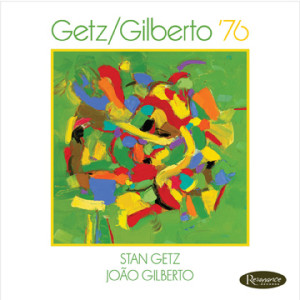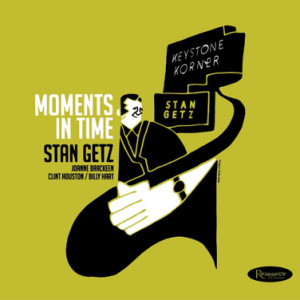Resonance Records continues its unparalleled string of historic jazz releases with two packages that document a week of shows at San Francisco’s Keystone Korner in 1976 by Stan Getz and his quartet, with special guest João Gilberto.
Stan Getz and João Gilberto’s Getz/Gilberto ’76
 The truly historic one of this pair is Getz/Gilberto ’76, a set of songs by the great Brazilian guitarist and singer, sometimes solo and sometimes accompanied by Getz and his combo: Joanne Brackeen on piano, Clint Houston bass and Billy Hart drums. Tenor saxophonist Getz, truly one of the most important American musicians of the jazz century, had nearly single-handedly brought bossa nova to America in the early 1960s with a trio of albums: Jazz Samba in 1962 with guitarist Charlie Byrd; and two with Gilberto, 1964’s Getz/Gilberto and 1966’s Getz/Gilberto 2. They had a reunion in 1972 at New York’s Rainbow Room, and in 1975 recorded The Best of Two Worlds which they promoted with this brief run at San Francisco’s fabled Keystone Korner.
The truly historic one of this pair is Getz/Gilberto ’76, a set of songs by the great Brazilian guitarist and singer, sometimes solo and sometimes accompanied by Getz and his combo: Joanne Brackeen on piano, Clint Houston bass and Billy Hart drums. Tenor saxophonist Getz, truly one of the most important American musicians of the jazz century, had nearly single-handedly brought bossa nova to America in the early 1960s with a trio of albums: Jazz Samba in 1962 with guitarist Charlie Byrd; and two with Gilberto, 1964’s Getz/Gilberto and 1966’s Getz/Gilberto 2. They had a reunion in 1972 at New York’s Rainbow Room, and in 1975 recorded The Best of Two Worlds which they promoted with this brief run at San Francisco’s fabled Keystone Korner.
The shows that week consisted of the Getz quartet playing opening and closing sets with Gilberto’s set sandwiched in between. The 12 musical tracks on Getz/Gilberto ’76 are drawn from that week’s performances, taped by club owner Todd Barkan. Gilberto was coming off a four-year performance hiatus, but the shy, diminutive Brazilian knocks everything out of the park in his brilliantly understated way.
It’s a mesmerizing program of bossa jazz with the “Sinatra of Brazil” singing the romantic Portuguese lyrics in his buzzing head voice. Highlights include the lilting “Chega de Saudade” by the great team of Antonio Carlos Jobim and Vinicius de Moraes (with a lovely solo from Getz); a stunning “Morena Boca de Ouro” whose fatalistic lines are sung with casual resignation by Gilberto; his own instrumental compositions “João Marcelo” and the up-tempo “Um Abraço No Bonfá”; and probably the song he’s best known for, “Aguas de Março.” The latter is truly an amazing performance as Gilberto casually displays the supple sense of rhythm for which he is known and revered. Tripping rapidly ahead of the beat through one line, lingering way behind it on the next like a mountain stream with alternating rapids and eddies, he nonetheless maintains a perfectly timed accompaniment on guitar. On some songs, Gilberto makes what he does seem deceptively easy (it’s not), but on “Aguas” he puts on a jaw-dropping display, with a song full of banal images that add up to a profound picture of the cyclical nature of life and death.
This release is available as a deluxe CD with a 32-page booklet, or a limited-edition vinyl LP. Both packages have lots of stunning black-and-white photos by iconic San Francisco photographer Tom Copi, and the cover illustration on this one is an abstract painting by Olga Albizu, whose work also graced the cover of Dave Brubeck’s mega-hit Time Out. The booklet includes essays by or interviews with Getz’s son Steve Getz, producers Zev Feldman and Todd Barkan, and musicians Joanne Brackeen and Billy Hart.
Stan Getz’s Moments in Time
By no means bringing up the rear is Moments in Time, which collects eight workouts by Getz and his quartet from that week’s worth of shows in The City. Here we finally get to see these players stretch out, never better displayed than on the nine-minute tracks that bookend the setlist, “Summer Night” and “Morning Star,” symbolically taking us through a full night of superlative jazz music. The former is as good an introduction to Getz’s genius as anything, as he sets up the piece with a lengthy introductory solo section. He’s just so coolly brilliant with his silky, almost vibrato-less tone that can make his tenor’s upper register sound nearly as clear and bell-like as an alto. Or nearly like a soprano as on the opening section of “Morning Star.”
workouts by Getz and his quartet from that week’s worth of shows in The City. Here we finally get to see these players stretch out, never better displayed than on the nine-minute tracks that bookend the setlist, “Summer Night” and “Morning Star,” symbolically taking us through a full night of superlative jazz music. The former is as good an introduction to Getz’s genius as anything, as he sets up the piece with a lengthy introductory solo section. He’s just so coolly brilliant with his silky, almost vibrato-less tone that can make his tenor’s upper register sound nearly as clear and bell-like as an alto. Or nearly like a soprano as on the opening section of “Morning Star.”
This disc is my introduction to all three of the other quartet members, all three of them brilliant. Brackeen is a marvel on the piano, whether vamping behind Getz or intensely soloing as she does on the swinging 12-minute take on Dizzy Gillespie’s “Con Alma.” Or in lyrical counterpoint with Getz as on Horace Silver’s ballad “Peace.” That’s a good place to start noticing Houston’s touch on bass, too. Hart is similarly impressive throughout, from subtle brushwork on the ballads to driving swing on Kenny Wheeler’s “The Cry Of The Wild Goose” and supple Latin rhythms on Jobim and Moraes’s “O Grande Amor.” It’s no wonder he went on to a full career of playing and teaching after his stint with Getz.
As you can tell from the tunes mentioned so far, this is a tour of top-notch jazz. And probably the best is the intensely melodic ballad “Infant Eyes” by the great Wayne Shorter, whose music can overshadow just about anybody’s on a setlist. Houston and Brackeen have a heart-rending duet toward the end of this eight-minute piece, too, backed by Hart’s keen sticks. And did I mention Duke’s “Prelude To A Kiss”?
This disc is available on CD, with a 28-page booklet similarly filled with goodies including expanded interviews with the musicians and essays by the producers, and more of Copi’s photos. Best of all, Moments in Time shows a mature Stan Getz at the height of his powers, returned to straight-ahead jazz after the excursion into fusion in the late ’60s and early ’70s (documented on Live at Montreux 1972). This is a must-have.
Resonance, 2016
